Recently Twelve Mile Circle focused a couple of articles on the boundaries of Virginia’s independent cities. That led loyal reader Scott Surgent to comment on an equally strange situation in Broomfield County, Colorado. I certainly knew about Broomfield because of its status as one of the newest and smallest of U.S. counties. It didn’t exist until 2001 and it covers only 34 square miles (88 square kilometres). I’ve even featured it on 12MC before, such as when county counter extraordinaire Fritz Keppler recalled his visit to Broomfield on the first day of its existence. However, I’d never examined its borders before.

Take a look at Broomfield on Google or even the county’s official street map. The borders seemed nothing if not bizarre. Narrow tendrils extend along roadways or tether nearly-detached rural acreage. Broomfield includes a couple of enclaves of neighboring counties within its body. It also owns a narrow exclave along a major roadway, barely wider than the lanes of traffic itself.
I wondered how this happened. So I drilled down a little closer into Broomfield’s multiple geo-oddities.
Broomfield as a Municipality
Broomfield’s origin explained its shape. It did not begin as a county, nobody originally envisioned it as a county, and it probably never would have become a county except for its unusual growth near four other counties. The county’s history page said that Broomfield began as a little village around the turn of the last century in the southeastern corner of Boulder County. Construction of the Boulder Turnpike in 1950 offered opportunities for growth. Then the Turnpike Land Company purchased acreage nearby and created a master planned community. Development led to further development and Broomfield continued to expand. Eventually it incorporated as a municipality in 1961.
A local publication, the Broomfield Enterprise, commented on the community’s success on the occasion of its 50th anniversary in 2011. Everything stemmed from bold actions. Broomfield didn’t compete with counties that surrounded it; rather Broomfield competed with nearby municipalities. Both offensive and defensive annexations occurred. Broomfield skillfully grabbed land in favorable locations and blocked other municipalities from doing the same. So this led to a crazy patchwork of boundaries typical of many municipalities in the United States.
Broomfield as a County
Eventually the municipality of Broomfield started to encounter a number of issues as it expanded. Once confined to Boulder County, it then encroached into Weld, Adams and Jefferson Counties, too. That meant it had to deal with four different governments, each with its own set of regulations, adjudication, taxation, services and schools. Governance in a quad county town became tedious and difficult.
Fortunately Colorado offered precedence. The state amended its constitution in 1902 to form the consolidated City and County of Denver. Could such a device also work for Broomfield? In 1998, the municipality reviewed the possibility: “Formation of a Broomfield City & County — Is it Feasible?” (pdf). The study concluded favorably. However, implementation required a state constitutional amendment. It also needed to survive a referendum by the citizens of Broomfield. Those steps happened and the municipality of Broomfield became the City and County of Broomfield on November 15, 2001.
Nonetheless, the amendment — Article 20, Sections 10-13 — placed limits on expansion. If froze Broomfield’s existing municipal borders until it could become a county. Afterwards, Broomfield could expand only after approval of a seven-member panel that included voting representatives from the four counties that surrounded it. That effectively cemented the weirdness of Broomfield’s final municipal boundaries into its county boundaries.
Let’s take a look, shall we?
Broomfield Border Overview
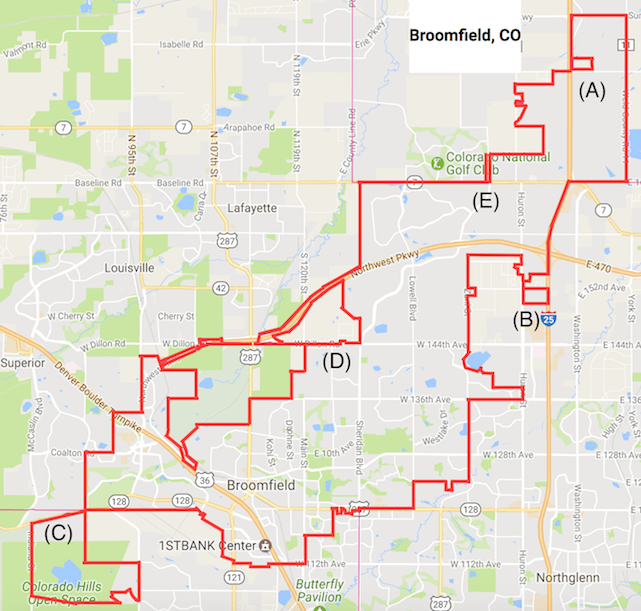
I had a hard time following some of the borders so I drew them out by hand with a wider line. I marked some of the peculiarities with letters. Hopefully that will make it easier to follow along when I show close-up images, below. I started at the top and proceeded clockwise.
(A) Weld County Enclave
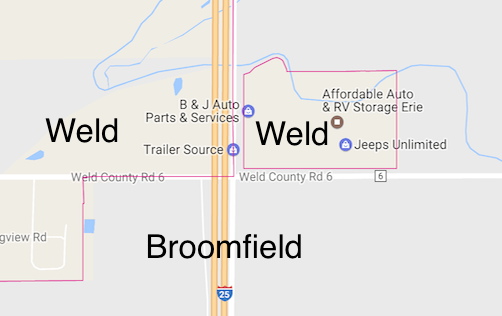
There didn’t seem to be much rhyme or reason for the tiny enclave of Weld County embedded within Broomfield. All I could figure was that maybe the owners of that land didn’t want to belong to Broomfield. In Colorado, local residents needed to vote affirmatively to join a municipality. Somehow this little pocket escaped Broomfield’s clutches as it expanded.
(B) Broomfield’s Eastern Tendril
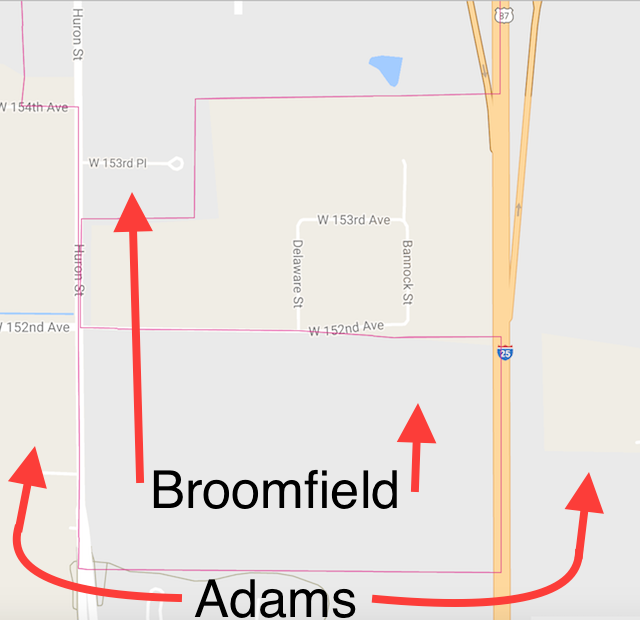
The little patch of Broomfield south of W. 152nd Ave. almost qualified as an exclave. I took an optimistic look, hoping it might be true. However, the width of Huron Road extended as a tendril connecting what appeared to be nothing more than an empty field, to the rest of the county. Who knew what future use Broomfield intended for this space? Regardless, Broomfield grabbed it.
(C) Broomfield’s Southwestern Tendril
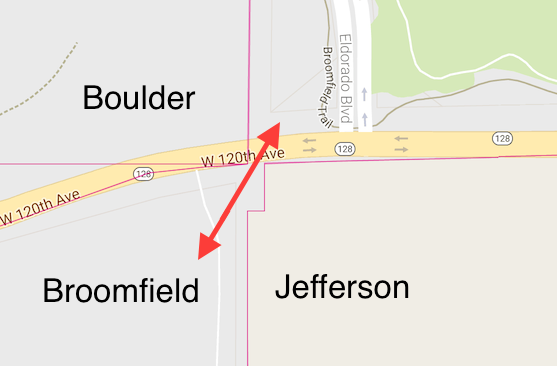
I thought I might have spotted a boundary cross. Upon closer inspection, however, I dispelled that possibility. Broomfield stuck a narrow corridor between Boulder and Jefferson along W. 120th Ave.
(D) Northwest Parkway Corridor
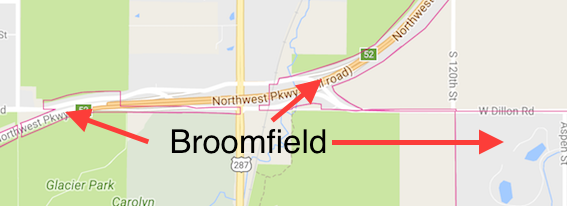
I could only describe the Northwest Parkway Corridor as a complete mess. Clearly, Broomfield coveted the parkway as it grew. Maybe if it controlled the parkway it could control access to and from the parkway. Like a castle wall, it could keep other municipalities at bay.
However, in the process, it created a confusing situation. It left a section of Boulder connected to its home county by two narrow corridors, along S. 104th St. and U.S. Route 287. It created a Broomfield exclave along the parkway and an adjoining exit ramp. It also created a Boulder enclave within Broomfield, separated from the rest of its home county solely by the width of W. Dillon Road.
(E) The Zigzag
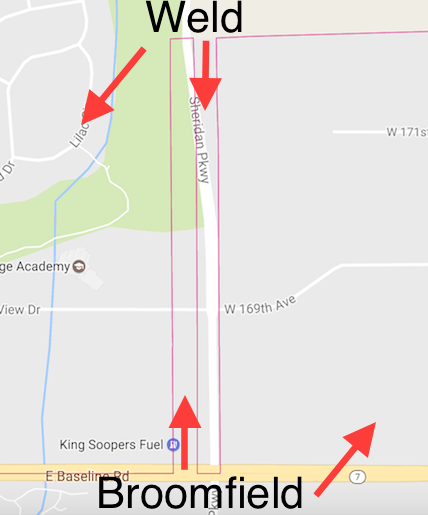
The strangeness of one section of the border between Broomfield and Weld completely confounded me. First, I didn’t know how to describe it. Zigzag seemed to fit, except it formed rectangular lines rather than triangular. Second, why? What purpose would it serve for Broomfield to erect that figurative wall so close to its own border? It didn’t even seem to include anything consequential. Maybe it had something to do with the golf course immediately to the west. I don’t know.

Leave a Reply